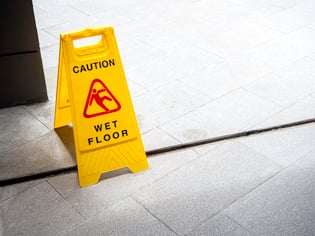National Safety Month began June 1, 2022, so today we’ll examine what it’s all about, including a breakdown of each of the four health and safety topics that will be targeted this year.
What is National Safety Month?
In an effort to mitigate common risks and safety hazards, the National Safety Council (NSC) recognizes the month of June as National Safety Month. This initiative strives to increase awareness surrounding preventable injuries, and tips for avoiding them.
While National Safety Month can be observed by anyone and everyone, it is especially pertinent to workplaces and their employees. With a reported 4 million occupational injuries requiring medical attention in 2020, it is far too common for unintentional, preventable injuries to occur while on the job.
In observance of this initiative, the NSC has dedicated each week of June to a specific safety and health topic. Below are this year’s subjects:
- Week 1 – Musculoskeletal Disorders

- Week 2 – Workplace Impairment
- Week 3 – Injury Prevention
- Week 4 – Slips, Trips, and Falls
Let’s take a closer look at the details of each of these issues: We’ll define what they are, discuss what commonly causes each to happen in the workplace, and suggest some initiatives you can take to address these common causes for injury and illness while on the job.
Week 1: Musculoskeletal Disorders
What They Are:
Musculoskeletal disorders (MSDs) are also referred to as ergonomic disorders: They account for things like hernias, strains, sprains, and tears.
Why They Happen:
These types of injuries occur due to overexertion and are most prevalent in employees who perform repetitive tasks and/or who work in awkward or unnatural positions for extended periods of time.
How to Prevent Them:
Below are some of the workplace safety tips OSHA suggests for preventing MSDs that form due to occupational habits:
- Training: Ensure your staff are trained and up to date on best practices when it comes to ergonomic safety, including how to maintain appropriate form and good posture while performing job tasks. You can refer to OSHA’s website for some training resources to strengthen your safety program.
- Symptom Reporting: It is also important to educate your employees about the early signs of MSDs and to encourage them to speak up if they start experiencing any symptoms: This will help your team to address the source of problematic procedures proactively.
- Developing Hazard Control Solutions: Take time for process audits, and study how certain activities correlate with an increased risk of ergonomic strain. When problematic processes are identified, OSHA suggests reengineering those practices to make them more efficient. For instance, you can invest in machinery to eliminate your employees’ need to perform certain repetitive tasks or unnatural motions.
Week 2: Workplace Impairments
What They Are:
The topic of workplace impairments covers anything that would prevent one from doing their job to their fullest potential.
These factors pose dangerous risks to your workplace safety and health: Those who are impaired while driving, operating machinery, or performing other manual work are at far greater risk of injury, or even fatality.
Why They Happen:
Predictive Safety cites that workplace impairments can be caused by factors including, “shift schedules, workplace cultures, and team dynamics”; however, it’s important to acknowledge that they may also be attributed to personal experiences such as substance use, fatigue, illness, mental distress, etc.
How to Prevent Them:
To prevent instances of workplace impairment and associated injuries, supervisors must be trained to recognize early signs of impairment and to address employees who they deem unfit to perform their typical responsibilities for any reason.
Employees should also be advised to exercise extra vigilance when reading medication guides and/or Black Box warning labels and abide by them while taking prescriptions, as some medications may have side effects such as drowsiness or muscle weakness.
Week two of National Safety Month serves as a great time to review your company’s existing policies surrounding workplace impairment. While the term is most commonly associated with drug and alcohol use, it also accounts for other sources of inhibited performance–including mental fatigue, distress, and illness–that your guidelines should address.
Consider instituting mental health initiatives to support your employees who are dealing with workplace impairment as a step toward supporting their wellbeing while working to eliminate unsafe conditions.
Week 3: Preventing Injuries
What They Are:
In week three, the NSC will focus on accidental injuries that occur while working.
Examples of some of these hazards include workers being struck by equipment, being involved in crashes or collisions, or being exposed to hazardous substances.
Why They Happen:
Accidental workplace injuries transpire when appropriate policies are not implemented or enforced: for example, when machinery or equipment is not being protected, supervised, or utilized properly.
How to Prevent Them:
Engage your employees and supervisors in safety training and enforce their compliance with all safety protocols.
It is also critical to ensure your employees have the tools and equipment they need to maintain a safe working environment [such as personal protective equipment (PPE) for construction workers.]
Week 4: Slips, Trips, and Falls
What They Are:
Slips, trips, and falls are instances where an injury occurs due to an employee losing their footing.
According to the NSC, falls are “the second leading cause of unintentional injury-related death,” and the CDC cites falls as “the number one cause of construction-worker fatalities, accounting for one-third of all on-the-job deaths in the industry.”
However, while the most prevalent and severe cases tend to come from the construction industry, slips, trips, and falls can happen anywhere, in any type of workplace.
Why They Happen:
Workplace slips, trips, and falls are most commonly associated with employees who fail to wear appropriate gear onsite, such as inappropriate shoes. They can also occur when site conditions do not comply with OSHA’s fall prevention guidelines.
How to Prevent Them:
Keeping a well-maintained working environment can reduce the risk of slips and trips–some steps you can take toward this include ensuring clutter is eliminated from walkways, keeping walking surfaces dry, and mandating that employees wear appropriate gear onsite (including shoes with sufficient traction and harnesses when working from heights.)
In Conclusion
Awareness and diligence in enforcing occupational safety and health protocols are critical for reducing onsite injuries. This month, we encourage all employers to observe, evaluate, enforce and improve their workplace safety procedures.
At FrankCrum, we reward clients who maintain effective safety management at their worksites by reimbursing participating clients with a percentage of their workers’ compensation charges based on the terms and conditions of this program. To learn more about the ways FrankCrum can help you create a workplace safety program, call 727-799-1150.




